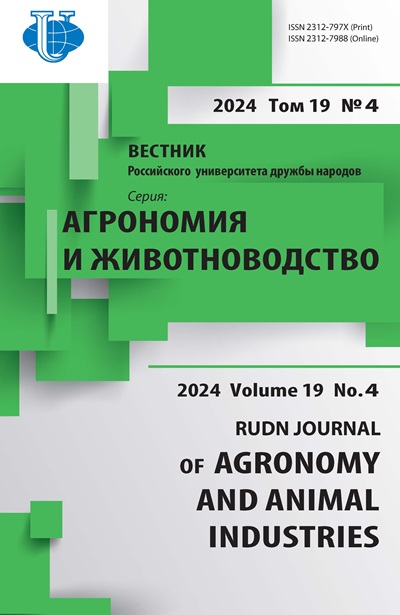Tributaries of the portal vein of the domestic cat
- Authors: Bylinskaya D.S.1, Shchipakin M.V.1
-
Affiliations:
- Saint Petersburg State University of Veterinary Medicine
- Issue: Vol 19, No 4 (2024)
- Pages: 641-650
- Section: Morphology and ontogenesis of animals
- URL: https://journal-vniispk.ru/2312-797X/article/view/315788
- DOI: https://doi.org/10.22363/2312-797X-2024-19-4-641-650
- EDN: https://elibrary.ru/BCMINU
- ID: 315788
Cite item
Full Text
Abstract
The portal vein is a large venous collector that collects venous blood from the organs of the gastrointestinal tract located in the abdominal cavity, with the exception of the caudal part of the rectum. The purpose of this study was to study ways of formation of portal vein in a domestic cat, to give the veins a morphometric characteristic. The material for the study was the corpses of cats, delivered to the Department of Animal Anatomy of the Saint Petersburg State University of Veterinary Medicine from veterinary clinics in St. Petersburg. In total, 15 cats were included in the study, the selection criterion for which was the absence of a history of infectious diseases, as well as diseases from the gastrointestinal tract; an average weight of the cats was 3500…3800 g. The research methods were fine anatomical dissection and morphometry. Previously, for fine anatomical dissection, the portal vein was injected with tinted latex. Four large veins take part in the formation of the portal vein of a cat. Splenic, right gastric, and gastrointestinal duodenum drain blood from the stomach of a domestic cat. Splenic and gastrointestinal veins are also involved in formation of blood outflow routes from pancreas and descending part of duodenum. The fourth branch of the portal vein, common trunk of mesenteric veins, is formed by fusion of cranial and caudal mesenteric veins. The cranial mesenteric vein collects blood from jejunum (along large jejunum veins), from iliac, caecum and ascending colon (iliac-colon vein). From transverse and descending colon, as well as the proximal rectum, blood outflow occurs through caudal mesenteric vein system.
About the authors
Darya S. Bylinskaya
Saint Petersburg State University of Veterinary Medicine
Author for correspondence.
Email: goldberg07@mail.ru
ORCID iD: 0000-0001-9997-5630
SPIN-code: 7627-0174
Candidate of Veterinary Sciences, Associate Professor, Associate Professor of the Department of Animal Anatomy
5 Chernigovskaya st., Saint Petersburg, 196084, Russian FederationMikhail V. Shchipakin
Saint Petersburg State University of Veterinary Medicine
Email: m.shchipakin@yandex.ru
ORCID iD: 0000-0002-2960-3222
SPIN-code: 7521-3140
Doctor of Veterinary Sciences, Professor, Head of the Department of Animal Anatomy
5 Chernigovskaya st., Saint Petersburg, 196084, Russian FederationReferences
- Melnikov S, Bylinskaya D, Zelenevskiy N, Shchipakin M, Khvatov V, Glushonok S. Methods for studying the ductus venosus in animals. FASEB Journal. 2022;(36): S1:3727. doi: 10.1096/fasebj.2022.36.S1.R3727
- Sidorova KA, Cheremenina NA, Veremeeva SA, Yesenbaeva KS, Kuzmina EN. Morphofunctional characteristics of rabbit liver. Agro-food policy of Russia. 2012;(12):65—67. (In Russ.).
- Veremeeva SA, Krasnolobova EP, Kozlova SV. Features of the liver in dogs. AIC: innovative technologies. 2018;(1):20—24. (In Russ.).
- Anisimova KA. Anatomy of the liver and bile-excreting system at pigs of breed Landrace at early stages of post-natal ontogenesis. Issues of legal regulation in veterinary medicine. 2017;(1):114—117. (In Russ.).
- Khvatov VA, Zelenevsky NV, Vasiliev DV. Peculiarities of the anatomy of the liver breeding system of the Persian breed cat. In: Current state and prospects of development of veterinary and zootechnical science: conference proceedings. Cheboksary; 2020. p.342—346. (In Russ.).
- Pervukhina IY, Seleznev SB, Esina DI. Ultrasound examination of the pancreas of dogs and cats. Theoretical and applied problems of agro-industry. 2010;(4):7—14. (In Russ.).
- Khvatov VA. Angiography of the portal liver vein of a Siamese cat. In: Actual problems of intensive development of animal husbandry: conference proceedings. Bryansk; 2023. p.331—333. (In Russ.).
- Levitskaya KA, Krasnolobova EP, Veremeeva SA. Anatomical and histological features of the internal organs of the fox. World of Innovation. 2023;(2):49—55. (In Russ.).
- Prusakov AV, Zelenevsky NV, Shchipakin MV, Virunen SV, Bylinskaya DC, Vasiliev DV. Sources of blood supply of the liver of a domestic cat. Issues of legal regulation in veterinary medicine. 2017;(2):123—125. (In Russ.).
- Prusakova AV, Zelenevsky NV. Features of the course and branching of the portal vein of the liver in goats of the Anglo-Nubian breed. In: From inertia to development: conference proceedings. Yekaterinburg; 2020. p.89—90. (In Russ.).
- Polyanskaya AI, Shchipakin MV. The main venous vessels of the stomach of a Yorkshire pig in the age aspect. Legal regulation in veterinary medicine. 2024;(1):105—108. (In Russ.). doi: 10.52419/issn2782—6252.2024.1.105
- Malenkikh NA, Melnikov SI. Venous vascularization of the trunk of a Landrace pig. In: Knowledge of the young for the development of veterinary medicine and the agro-industrial complex of the country: conference proceedings. Saint Petersburg; 2022. p.251—252. (In Russ.).
- Veremeeva SA. Morphological features of the arteries and biliary tract of the dog’s liver. In: Modern trends in the development of science in animal husbandry and veterinary medicine: conference proceedings. Tyumen; 2019. p.78—81. (In Russ.).
- Tabakova MA, Ryadinskaya NI. Histological structure of the liver of Baikal seal. In: Problems of species and age morphology: conference proceedings. Ulan-Ude; 2019. p.125—134. (In Russ.).
- Ryadinskaya NI, Tabakova MA. Anatomy features of structure, topography and blood supply of liver in Baikal seal (Phoca sibirica). Marine mammals of the Holarctic: conference proceedings. Volume 2. Astrakhan; 2018; p.137—142. (In Russ.).
- Barteneva YY, Zelenevskiy NV. The morphology of the liver and gall bladder of Eurasian lynx. Hippology and veterinary medicine. 2013;3(9):94—97. (In Russ.).
Supplementary files










